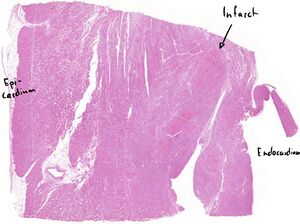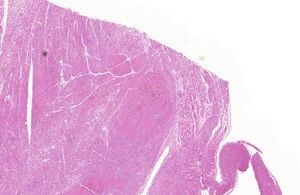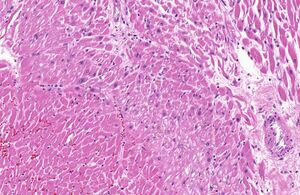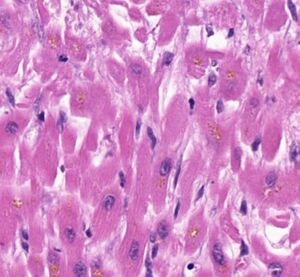3. Recent infarct of the heart

Staining: HE Organ: Heart
Description: On the left side of the slide we can see fat cells, belonging to the sub-epicardial fat. Therefore, the endocardium is to the right on the slide. We can see mostly a normal myocardium, however there is a more eosinophilic area under the endocardium. If we zoom in we can see that the cells are more eosinophilic, there are few nuclei visible, and the cross-striation has mostly disappeared in comparison to the other areas. We can see some red blood cells among the myocardial cells. We can see some leukocytes (small round nuclei) along the demarcation zone, the zone on the outer parts of the eosinophilic area. There are some fibroblasts (elongated cells) among the muscle cells. Lipofuscin is also present.
Diagnosis: Fresh myocardial infarction

Theory: The eosinophilic area is necrotic, showing that this is a myocardial infarction. The infarct is limited to a small area beneath the endocardium, showing that this is a subendocardial infarct and not a transmural one. Infarcts always start in the endocardium, and only in certain cases will the infarct become transmural. The leukocytes are mostly granulocytes that appear in response to the necrosis. There is already some immigration of fibroblasts that are here to heal the infarct by produce scar tissue. Lipofuscin is a sign of wear and tear on the cells and are not associated with this infarct. Because the necrosis is visible (eosinophilia, no nuclei), but there are no visible white blood cells, the infarct is in the acute phase, meaning it is around 1-2 days old.

The presence of RBCs is not normal in infarcts. They can be present if a procedure called percutaneous transluminal coronary angioplasty (PTCA) was performed. During this procedure, a “balloon” is led into the blocked coronary artery where the balloon “blows itself up”, so the artery is dilated and blood flow is restored. This causes some RBCs to leak into the necrotic tissue.

